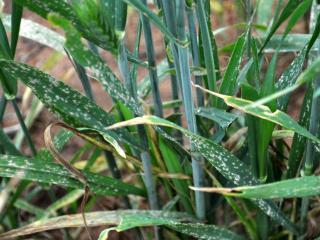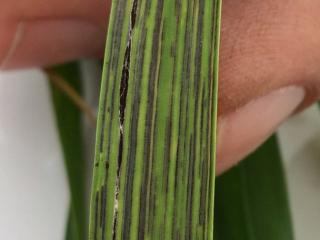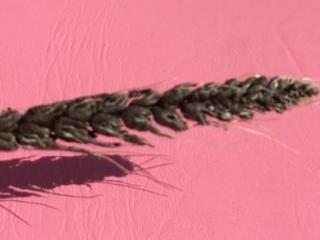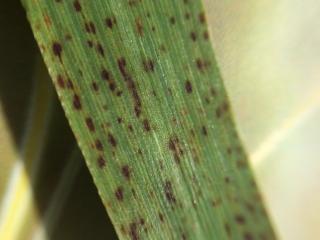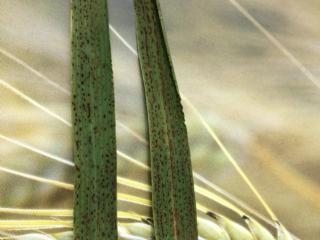Barley and wheat disease update
Powdery mildew in wheat
- Coomalbidgup
Plant pathologist Andrea Hills (DPIRD) reports finding powdery mildew in flowering Scepter wheat near Coomalbidgup. Up to 60% of the crop was infected. The crop had been sprayed but the powdery mildew was reappearing. When Andrea checked DS Pascal wheat in the neighbouring paddock powdery mildew was noticeably absent. The Pascal wheat was at dough development.
DS Pascal is rated as being resistant (R) to powdery mildew while Scepter is moderately susceptible to susceptible (MSS). Selecting wheat varieties with even moderately resistant to moderately susceptible (MRMS) resistance provides useful disease protection.
For more information on diagnosing and managing this disease refer to DPIRD’s Managing powdery mildew in wheat page.
Flag smut of wheat
- Cadoux
David Stead (Anasazi Agronomy) reports finding flag smut in Mace wheat near Cadoux.
Mace is rated as being susceptible (S) to flag smut.
Infected wheat plants leaves, leaf sheaths and occasionally stems have long grey-black streaks with powdery black spores (which rub off easily) on them.
Spores of the fungus can survive in soil for up to seven years. In paddocks contaminated with flag smut, use clean fungicide-treated seed of resistant varieties the following season to reduce disease risk. Disease rating information for varieties can be checked in DPIRD’s wheat disease ratings.
The disease is also well-managed by fungicide seed dressing
For more information refer to DPIRD’s Diagnosing flag smut of wheat and Smut and bunt diseases of cereal - biology, identification and management pages.
Covered smut in barley
- Westcliffe
Development officer Stacey Hansch (DPIRD) has found covered smut in flowering Spartacus barley near Westcliffe.
Infected barley heads may emerge slightly later than healthy heads and become trapped in the boot and emerge from the leaf sheath below the flag leaf. All of the grains in an infected head are replaced by brown-black masses of spores.
The smut masses do not break up readily or blow away as happens with loose smut. The smut spores are released during harvest and contaminate clean seed, machinery and soil. The presence of barley smut may downgrade quality or exclude barley from delivery.
This disease is well-managed by regular application of fungicide seed dressing, selecting resistant varieties, using uncontaminated seed and paddock rotation. Variety information is available in DPIRD’s barley variety guide.
There are a number of different smut diseases of cereals and their identification is important.
For more information refer to DPIRD’s; Diagnosing covered smut in barley and Smut and bunt diseases of cereal - biology, identification and management pages.
Physiological leaf spotting symptoms look similar to spot-type net blotch
- Westcliffe
Development officer Stacey Hansch (DPIRD) recently found physiological leaf spotting (PLS) in Flinders barley near Westcliffe. The crop was at ear emergence. It was originally suspected that it might be spot-type net blotch (STNB). However the numerous small, dark spots are characteristic of a PLS type reaction in Flinders.
Plant pathologist Andrea Hills (DPIRD) advises that the presence of small dark coloured spots on leaves should not always be presumed to be STNB.
PLS is a response to an abiotic stress (that is, not a pathogen) and is not thought to affect yield. Spot symptoms differ with barley varieties, for example, infected Stirling barley plants have very small pale to orange pinprick spots while Vlamingh barley spots are 1-2mm, brown to dark brown spots that may increase in size. Spots most commonly develop from stem elongation to flag leaf emergence. The most common type of PLS symptom seen in barley is a ‘thumbprint’ or smudge which tends to occur on the margins of leaves.
Sometimes small dark spots are the start of STNB but in the case above, the variety, number of spots and the fairly linear distribution of spots along the leaf blade distinguishes them as PLS.
Boron toxicity (from alkaline soils) also causes dark spots but these are usually (but not always) on the margins of leaves.
It is recommended that where there is any doubt about the cause of cereal leaf spotting then confirmation that it is a fungal disease should occur before any foliar fungicides are applied. Assistance with disease identification can be obtained from DDLS - Plant pathology services (phone +61 (0)8 9368 3351), this is a chargeable service, and can be worthwhile to avoid unnecessary application of fungicide.
Growers can also use the PestFax Reporter app to diagnose symptoms.
For more information see DPIRD’s Diagnosing physiological leaf spot in barley.
For foliar fungicide information refer to the department’s Registered foliar fungicides for cereals in Western Australia page.
For more cereal disease information contact Kithsiri Jayasena, Plant Pathologist, Albany on +61 (0)8 9892 8477, Geoff Thomas, Plant Pathologist, South Perth on +61 (0)8 9368 3262 or Andrea Hills, Plant Pathologist, Esperance on +61 (0)8 9083 1144 or Ciara Beard, Plant Pathologist, Geraldton on +61 (0)8 9956 8504.

